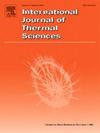Balance regulation of heat transfer and flow performances of convective heat exchange of microchannel array structures
IF 4.9
2区 工程技术
Q1 ENGINEERING, MECHANICAL
International Journal of Thermal Sciences
Pub Date : 2025-03-19
DOI:10.1016/j.ijthermalsci.2025.109882
引用次数: 0
Abstract
As chip integration density increases, the demand for efficient thermal management becomes critical. Traditional microchannel structures often face a trade-off between heat transfer enhancement and increased flow resistance. To address this issue, this study proposes a novel reverse optimization strategy for microchannel array structures, inspired by the natural configurations of leaf veins and spider webs. The optimization process involves two key stages: first, minimizing the maximum thermal resistance of individual microchannel units; second, reducing overall flow resistance through an inverse design approach. The optimized structure is experimentally validated against randomly designed comparative structures. The results demonstrate that the optimized structure achieves a comprehensive performance improvement ranging from 1.54 to 4.47 times over comparative structures. Furthermore, within the scope of this study, the optimized configuration reduces the pressure drop by 23 %–81 % while maintaining high heat transfer efficiency. This research contributes to the development of optimized microchannel array designs for active thermal management systems.
微通道阵列结构对流换热传热与流动性能的平衡调节
随着芯片集成密度的增加,对高效热管理的需求变得至关重要。传统的微通道结构经常面临传热增强和流动阻力增加之间的权衡。为了解决这一问题,本研究提出了一种新的微通道阵列结构逆向优化策略,该策略的灵感来自叶脉和蜘蛛网的自然构型。优化过程包括两个关键阶段:首先,最小化单个微通道单元的最大热阻;其次,通过逆向设计方法降低总体流动阻力。优化后的结构与随机设计的比较结构进行了实验验证。结果表明,优化后的结构比比较结构的综合性能提高了1.54 ~ 4.47倍。此外,在本研究范围内,优化后的结构在保持高传热效率的同时,将压降降低了23% - 81%。本研究有助于主动热管理系统优化微通道阵列设计的发展。
本文章由计算机程序翻译,如有差异,请以英文原文为准。
求助全文
约1分钟内获得全文
求助全文
来源期刊

International Journal of Thermal Sciences
工程技术-工程:机械
CiteScore
8.10
自引率
11.10%
发文量
531
审稿时长
55 days
期刊介绍:
The International Journal of Thermal Sciences is a journal devoted to the publication of fundamental studies on the physics of transfer processes in general, with an emphasis on thermal aspects and also applied research on various processes, energy systems and the environment. Articles are published in English and French, and are subject to peer review.
The fundamental subjects considered within the scope of the journal are:
* Heat and relevant mass transfer at all scales (nano, micro and macro) and in all types of material (heterogeneous, composites, biological,...) and fluid flow
* Forced, natural or mixed convection in reactive or non-reactive media
* Single or multi–phase fluid flow with or without phase change
* Near–and far–field radiative heat transfer
* Combined modes of heat transfer in complex systems (for example, plasmas, biological, geological,...)
* Multiscale modelling
The applied research topics include:
* Heat exchangers, heat pipes, cooling processes
* Transport phenomena taking place in industrial processes (chemical, food and agricultural, metallurgical, space and aeronautical, automobile industries)
* Nano–and micro–technology for energy, space, biosystems and devices
* Heat transport analysis in advanced systems
* Impact of energy–related processes on environment, and emerging energy systems
The study of thermophysical properties of materials and fluids, thermal measurement techniques, inverse methods, and the developments of experimental methods are within the scope of the International Journal of Thermal Sciences which also covers the modelling, and numerical methods applied to thermal transfer.
 求助内容:
求助内容: 应助结果提醒方式:
应助结果提醒方式:


